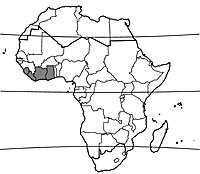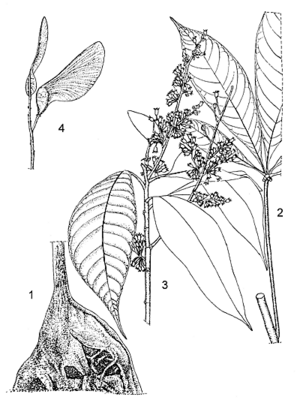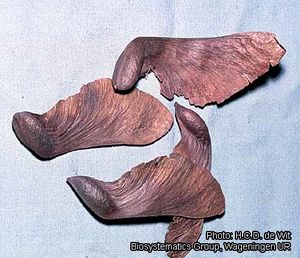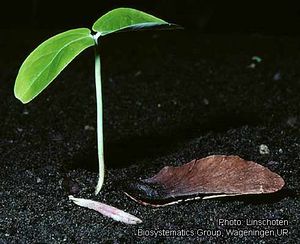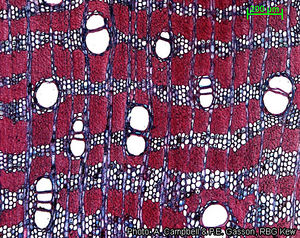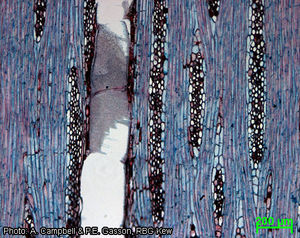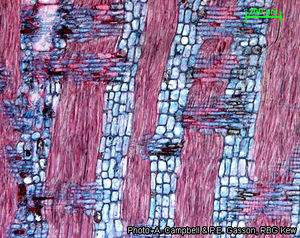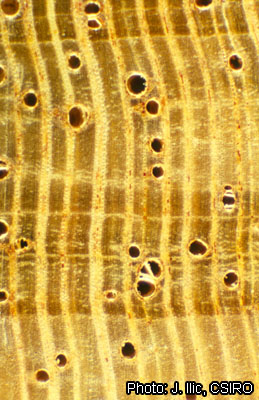Heritiera utilis (PROTA)
Introduction |
| General importance | |
| Geographic coverage Africa | |
| Geographic coverage World | |
| Dye / tannin | |
| Medicinal | |
| Timber | |
| Ornamental | |
| Conservation status | |
Heritiera utilis (Sprague) Sprague
- Protologue: Bull. Misc. Inform. Kew 1909: 348 (1909).
- Family: Sterculiaceae (APG: Malvaceae)
- Chromosome number: 2n = 32
Synonyms
- Tarrietia utilis (Sprague) Sprague (1916).
Vernacular names
- Niangon, nyankom, red cedar, cola cedar, whismore (En).
- Niangon (Fr).
Origin and geographic distribution
Niangon is restricted to the West African forest zone, where it occurs from Sierra Leone to Ghana. However, it has been found in some localities in the savanna zone, in remnants of evergreen rain forest, e.g. at the foot of the Loma mountains in Sierra Leone and in riparian forest in the savanna zone in Côte d’Ivoire.
Uses
The wood is widely used for exterior and interior joinery, panelling, flooring, moulding, carpentry, furniture, cabinet work, stairs (inside), shipbuilding (planks, deck), and sliced veneer for interior and exterior faces of plywood. Locally, it is popular for making canoes, oars and planks for house building. It has been used for shingles.
The bark has been used for tanning leather. In Côte d’Ivoire the wood is considered to have antidysenteric properties. The bark also has medicinal applications, a decoction being applied to skin affections caused by leprosy and taken internally as an aphrodisiac. The seeds are reportedly edible; the seed oil is used as an aphrodisiac, whereas ground seeds are applied to abscesses.
Production and international trade
Niangon timber has been exported in large quantities for decades, mainly from Côte d’Ivoire. In 1984 exports from Côte d’Ivoire reached a peak of 145,000 m³, thereafter declining dramatically to 3600 m³ in 1989, and increasing again to 30,000 m³ in 1991. By then, however, the logs exported from Côte d’Ivoire originated mainly from forests in Liberia. In 1995 Côte d’Ivoire exported 41,000 m³ of logs at an average price of US$ 311/m³, Ghana 5000 m³ of sawn timber at an average price of US$ 653/m³, and Liberia 4000 m³ of logs at an average price of US$ 250/m³. The timber is mainly exported to countries of the European Union. In 2004 the average free-on-board price of round logs ranged between US$ 250 and US$ 275 per m³. The volumes exploited constitute 1–2% of the total commercial log production in West Africa.
Properties
The heartwood is pale pink to red-brown, usually distinctly demarcated from the whitish sapwood, which is 3–7.5 cm thick. The grain is interlocked, texture moderately coarse. The wood is oily to the touch, and there is a distinct silver grain.
The wood is moderately heavy. The density is (510–)625–700(–750) kg/m³ at 12% moisture content. The shrinkage rates are moderately high: from green to 12% moisture content about 2.5% radial and 4.5% tangential, and from green to oven dry 2.9–5.0% radial and 5.9–10.1% tangential. The timber dries fairly easy and fairly rapidly, but often with a tendency to twist and occasional end surface checking. Once dry, it is moderately stable in service.
At 12% moisture content, the modulus of rupture is 74–171 N/mm², modulus of elasticity 9120–14,400 N/mm², compression parallel to grain 38–62 N/mm², shear 4–13 N/mm², cleavage 12–22 N/mm, Janka side hardness 3740–4890 N and Janka end hardness 3740–5330 N.
The wood blunts edged tools moderately rapidly due to the presence of interlocked grain, and there is a risk of tearing in machining and of clogging due to the presence of resin. Stellite-tipped sawteeth are recommended. A cutting angle of 15° is recommended when planing to prevent tearing. Peeling is difficult due to irregular logs. Filling is recommended to obtain a good finish. The nailing and screwing properties are good, although splitting may occur. Gluing does not cause problems. The bending properties are moderate, staining and polishing satisfactory.
The heartwood is moderately durable. It is moderately resistant to fungi and termites, but resistant to dry-wood borers; the sapwood is liable to powder-post beetle attack. The heartwood is extremely resistant to preservative treatment. The wood may cause dermatitis, although it is generally considered non-toxic and non-allergenic.
Adulterations and substitutes
The woods of Heritiera densiflora (Pellegr.) Kosterm. from Gabon and Heritiera javanica (Blume) Kosterm. from tropical Asia have similar properties to those of Heritiera utilis wood, although they are usually slightly higher in density. Niangon timber is also traded as a substitute for African mahogany (Entandrophragma and Khaya spp.).
Description
- Medium-sized to large tree up to 35(–45) m tall; bole cylindrical but often crooked, branchless for up to 20(–30) m, up to 150(–300) cm in diameter, with high, thin and arched buttresses or with stilt-like buttresses (especially well developed in swamp forest); bark pale brown, thin, smooth; crown compact and rounded, with golden to bronze colour when viewed from below.
- Leaves alternate, simple or digitately compound; stipules c. 0.5 cm long, early caducous; petiole 1–25 cm long; blade 5–30 cm × 2–10 cm in outline, elliptical when simple or with 5–7 leaflets, cuneate at base, acuminate at apex, densely and contiguously bronze scaly hairy below, pinnately veined with 8–18 pairs of lateral veins.
- Inflorescence an axillary, narrow panicle up to 20 cm long, reddish brown pubescent; bracts c. 1 cm long, caducous.
- Flowers unisexual, regular, 4–5-merous, whitish or cream-coloured, c. 0.5 cm long; pedicel slender, 0.5–1 cm long; calyx campanulate with lobes about as long as tube, stellately hairy; petals absent; disk annular, orange; male flowers with stamens fused into a column; female flowers with 4–6 carpels united loosely.
- Fruit consisting of 1–6 woody nuts c. 2.5 cm × 1.5 cm with a large wing c. 8 cm × 3 cm.
- Seedling with epigeal germination; hypocotyl 10–15 cm long, scaly especially towards apex, epicotyl 2–3 cm long; cotyledons leafy, obovate, 6–7 cm long, 3-veined from the base.
Other botanical information
Heritiera comprises about 35 species, the majority of which occur in tropical Asia and 3 species in Africa. Heritiera utilis is closely related to Heritiera densiflora (Pellegr.) Kosterm. from Gabon. The two species should be carefully compared as they are very similar and most of the recorded differences are obscure, e.g. density of indumentum and length of inflorescences. Both species often have simple leaves, but Heritiera utilis may have digitately compound leaves (with leaflets completely free) and Heritiera densiflora may have digitately lobed leaves (with lobes distinctly fused at base).
Anatomy
Wood-anatomical description (IAWA hardwood codes):
- Growth rings: (1: growth ring boundaries distinct); (2: growth ring boundaries indistinct or absent).
- Vessels: 5: wood diffuse-porous; 13: simple perforation plates; 22: intervessel pits alternate; 23?: shape of alternate pits polygonal; 24: intervessel pits minute (≤ 4 μm); 25: intervessel pits small (4–7 μm); 30: vessel-ray pits with distinct borders; similar to intervessel pits in size and shape throughout the ray cell; (36: helical thickenings in vessel elements present); (37: helical thickenings throughout body of vessel element); 43: mean tangential diameter of vessel lumina ≥ 200 μm; 46: ≤ 5 vessels per square millimetre; 58: gums and other deposits in heartwood vessels.
- Tracheids and fibres: 61: fibres with simple to minutely bordered pits; 63: fibre pits common in both radial and tangential walls; 66: non-septate fibres present; 69: fibres thin- to thick-walled.
- Axial parenchyma: 76: axial parenchyma diffuse; 77: axial parenchyma diffuse-in-aggregates; 79: axial parenchyma vasicentric; 86: axial parenchyma in narrow bands or lines up to three cells wide; (89: axial parenchyma in marginal or in seemingly marginal bands); (90: fusiform parenchyma cells); 91: two cells per parenchyma strand; 92: four (3–4) cells per parenchyma strand.
- Rays: 98: larger rays commonly 4- to 10-seriate; (102: ray height > 1 mm); (103: rays of two distinct sizes); 106: body ray cells procumbent with one row of upright and/or square marginal cells; 107: body ray cells procumbent with mostly 2–4 rows of upright and/or square marginal cells; 110: sheath cells present; 114: ≤ 4 rays per mm; 115: 4–12 rays per mm.
- Storied structure: 120: axial parenchyma and/or vessel elements storied; 121: fibres storied; 122: rays and/or axial elements irregularly storied.
- Mineral inclusions: (136: prismatic crystals present); (137: prismatic crystals in upright and/or square ray cells); (140: prismatic crystals in chambered upright and/or square ray cells); (142: prismatic crystals in chambered axial parenchyma cells); (154: more than one crystal of about the same size per cell or chamber).
Growth and development
Seedlings develop a taproot with numerous lateral roots. Seedling leaves are simple until about the tenth leaf, when seedlings are 25–30 cm tall, and subsequently they start developing compound leaves with 3 leaflets until about 50 cm tall. From then on 5-foliolate leaves are formed until the seedling is about 1 m tall and 15 months old, when 7-foliolate leaves may appear. The leaves increase in size until the seedling is 4–5 years old, with leaflets up to 60 cm × 20 cm; after that leaf size decreases. The sapling grows without branching until 5–6 years old and 5–7 m tall. At the same age the stilt-like buttresses may start to develop. Simple leaves develop near the surface of the crown of larger trees. Natural pruning is quite good, but the bole is nevertheless often slightly sinuous, especially in swamp forest.
Niangon is a light demander, but seedlings and saplings can tolerate shade for years and start to grow immediately once the canopy is opened. In Ghana seedling growth rates of 27–65 cm in natural forest and 22.5–90 cm in the nursery have been recorded for the first year. Plantation trees in Sierra Leone showed an average annual diameter growth of 1.7 cm over the first 15 years, and they reached a height of 20 m after 15 years. In plantations without shade trees in Côte d’Ivoire, the average growth is up to 1 m/year during the first 4–5 years, but then accelerates to 2 m/year until 10 years old. In a 62-year-old plantation in Côte d’Ivoire, mean annual bole diameter increment was 1 cm for the largest trees (20% of all trees), but in natural forest it is about 0.4 cm. In plantations the timber can be harvested after 50–60 years, when the boles have attained an average diameter of 50 cm. Trees are evergreen, and new leaves appear twice a year during the rainy seasons, more or less simultaneously in all trees. They flower in October–November and fruit from January to March, which is towards the end of the dry season. Trees start setting fruit when 15–17 years old. The fruits may be dispersed by wind, but they are not very light and do not travel far.
Ecology
Niangon occurs in evergreen forest, moist semi-deciduous forest and gallery forest, also in secondary forest, rarely higher than 500 m altitude. It is often found along watercourses and in swamps, being very drought-sensitive. However, trees with best-shaped boles occur on well-drained localities. Niangon occurs in regions with an annual rainfall of 1500–2500 mm. It seems to prefer loamy soils to sandy soils. It has a tendency to patchy occurrence; locally it is very common, elsewhere it occurs only scattered. Niangon reaches the middle and upper strata of the forest, but is not an emergent tree. In Liberia an average density of 2 trees over 40 cm in bole diameter and 0.5 trees over 60 cm in diameter has been recorded per ha. In Côte d’Ivoire an average of 5 exploitable trees per ha was recorded at the end of the 1950s, but stands have been largely depleted since.
Propagation and planting
Niangon is propagated by seed. One kilogramme contains about 1250 seeds. The seeds are recalcitrant and have no dormancy. Germination starts after (2–)3–4 days. Fresh seeds have high germination rates, up to over 80% within 2 weeks. The seed is put into the soil with the wing protruding. Saplings were usually planted in the field when 18–30 months old and 1–1.5 m tall, but nowadays are often already planted out when 8–9 months old and 30–50 cm tall. Potted seedlings, bare-rooted seedlings or striplings are used as planting material. Pruning of lateral roots about one month before transplanting promotes the formation of a dense system of short lateral roots, enhancing the chance of successful establishment in the field. Spacing varies from 3 m × 3 m to 5 m × 5 m, depending on the cropping system (pure plantation, taungya system or agroforestry system). Natural regeneration in the forest may be abundant, especially where the canopy has been disturbed but not entirely removed. In years with few fruits, wildlings are sometimes transplanted to the nursery.
Management
Niangon timber is generally produced in natural forest managed under a selective logging system, where logs are removed based on minimum diameter and in a cyclical manner, with or without silvicultural treatment. The minimum diameter varies between countries, ranging from 50 cm in Côte d’Ivoire to 70 cm in Ghana at 1.3 m above ground level or 30 cm above the buttresses. The length of the cutting cycle also varies, ranging from 15 years to 60 years. In Ghana the felling intensity per km² is based on the ratio between the number of stems above 70 cm diameter and the number of stems in the 50–69 cm diameter class after a 100% inventory. When the ratio is 1:1, 70% of the stock above 70 cm diameter can be harvested, but generally 50–70% is harvested.
Several planting systems have been tried in Côte d’Ivoire. The first plantations covering about 100 ha were established in 1930. Striplings of 1.5 m tall were planted at 2 m × 2 m in forest in which the undergrowth had been cleared and smaller trees girdled. Subsequently girdling of the canopy trees was practised until 5 years after planting, and thinning was done regularly, resulting in 400–550 niangon trees per ha, with straight and clean boles and an average annual diameter growth of 0.5 cm. This is a labour-intensive method. From 1931 to 1948 about 2700 ha of natural forest was enriched by line planting of niangon. Lines 2 m wide were cut at 10–25 m intervals, trees were poisoned, niangon striplings planted at a spacing of 5 m, weeding was done during the first 5 years as was regular thinning, resulting in about 380 niangon trees per ha. This method is less labour-intensive, but was abandoned because of difficulties with weeding and poisoning. Niangon was sometimes planted in a mixture with other valuable timber species, notably Khaya ivorensis A.Chev. Later the taungya system was used to plant about 400 ha of niangon trees, and since 1986 about 180 ha of plantations have been successfully established using seedlings of 30–50 cm tall, planted in full sunlight. In 1950 niangon originating from Côte d’Ivoire was introduced in forest near Kribi, Cameroon.
Diseases and pests
Numerous insects may attack niangon, but damage is usually of minor importance. Nursery stock may be attacked by galling insects and top-shoot coleopterous and lepidopterous borers. It has been observed that larvae of the lepidopterous Anaphe venata eat the leaves in natural forest, as is the case with several other coleopterous and lepidopterous insects.
Harvesting
Timber harvesting is done year-round, but mostly during the dry season. Harvesting involves felling of trees and cross cutting the logs. The logs are skidded to a central log yard using crawlers or wheeled tractors fixed with winches.
Yield
Based on forestry practice in Ghana, sustainable harvest of niangon ranges from 5 to 80 stems per km², depending on forest type and density of the species. The average merchantable bole volume per tree is 6–7 m³. The mean annual timber production in niangon plantations in Côte d’Ivoire is 8–14 m³/ha.
Handling after harvest
Logs are debarked soon after felling to prevent attack from powder-post beetles, which lay their eggs under the bark and of which the larvae may attack the sapwood. Spraying with insecticides may also be practised. Fungicides may be applied to avoid discoloration by stain or decaying fungi. The logs are transported from the log yards to processing mills or log markets using articulated hauling rigs. They are sorted into end use categories, i.e. sawn wood, veneer or export logs, and stacked in piles or put in log ponds. The timber is either exported as round logs if there is no ban on log exports, or processed in local mills into sawn wood, veneer or plywood before export. The products are exported according to specifications demanded by the customer and packaged according to standard shipping rules and regulations.
Genetic resources
Heritiera utilis is classified on the IUCN red list as vulnerable, being considered at high risk of extinction in the wild in the medium-term future as a result of serious reduction of populations in recent years. In Ghana it is rated as a ‘red star species’, indicating that current rates of exploitation represent a significant danger of genetic erosion.
Prospects
Being an excellent timber but also a red list species, sustainable production of niangon from natural resources will require intensive management. Niangon is a good candidate for plantation establishment and reforestation in the humid evergreen forest zone of West Africa. Although there is already a good deal of experience with plantations in Côte d’Ivoire, more research is needed, especially concerning silvicultural treatments of natural forest, provenance trials and optimal methods of propagation.
Major references
- Burkill, H.M., 2000. The useful plants of West Tropical Africa. 2nd Edition. Volume 5, Families S–Z, Addenda. Royal Botanic Gardens, Kew, Richmond, United Kingdom. 686 pp.
- Chudnoff, M., 1980. Tropical timbers of the world. USDA Forest Service, Agricultural Handbook No 607, Washington D.C., United States. 826 pp.
- CIRAD Forestry Department, 2003. Niangon. [Internet] Tropix 5.0. http://tropix.cirad.fr/afr/niangon.pdf. May 2005.
- Dupuy, B. & Chézeaux, E., 1994. La sylviculture du niangon en plantation. Bois et Forêts des Tropiques 239: 9–22.
- Holmgren, M., Poorter, L., Siepel, A., Bongers, F., Buitelaar, M., Chatelain, C., Gautier, L., Hawthorne, W.D., Helmink, A.T.F., Jongkind, C.C.H., Os-Breijer, H.J., Wieringa, J.J. & van Zoest, A.R., 2004. Ecological profiles of rare and endemic species. In: Poorter, L., Bongers, F., Kouamé, F.N’. & Hawthorne, W.D. (Editors). Biodiversity of West African forests. An ecological atlas of woody plant species. CAB International, Wallingford, United Kingdom. pp. 101–389.
- Richter, H.G. & Dallwitz, M.J., 2000. Commercial timbers: descriptions, illustrations, identification, and information retrieval. [Internet]. Version 18th October 2002. http://delta-intkey.com/wood/index.htm. May 2005.
- Voorhoeve, A.G., 1979. Liberian high forest trees. A systematic botanical study of the 75 most important or frequent high forest trees, with reference to numerous related species. Agricultural Research Reports 652, 2nd Impression. Centre for Agricultural Publishing and Documentation, Wageningen, Netherlands. 416 pp.
Other references
- Abbiw, D.K., 1990. Useful plants of Ghana: West African uses of wild and cultivated plants. Intermediate Technology Publications, London and Royal Botanic Gardens, Kew, Richmond, United Kingdom. 337 pp.
- Aubréville, A., 1959. La flore forestière de la Côte d’Ivoire. Deuxième édition révisée. Tome deuxième. Publication No 15. Centre Technique Forestier Tropical, Nogent-sur-Marne, France. 341 pp.
- Brunck, F., 1994. Les ravageurs et maladies du niangon. Bois et Forêts des Tropiques 239: 23–42.
- InsideWood, undated. [Internet] http://insidewood.lib.ncsu.edu/search/. May 2007.
- Takahashi, A., 1978. Compilation of data on the mechanical properties of foreign woods (part 3) Africa. Shimane University, Matsue, Japan, 248 pp.
Sources of illustration
- Voorhoeve, A.G., 1979. Liberian high forest trees. A systematic botanical study of the 75 most important or frequent high forest trees, with reference to numerous related species. Agricultural Research Reports 652, 2nd Impression. Centre for Agricultural Publishing and Documentation, Wageningen, Netherlands. 416 pp.
Author(s)
- K.A. Adam, Forestry Research Institute of Ghana (FORIG), University P.O. Box 63, KNUST, Kumasi, Ghana
Correct citation of this article
Adam, K.A., 2005. Heritiera utilis (Sprague) Sprague. In: Louppe, D., Oteng-Amoako, A.A. & Brink, M. (Editors). PROTA (Plant Resources of Tropical Africa / Ressources végétales de l’Afrique tropicale), Wageningen, Netherlands. Accessed 31 March 2025.
- See the Prota4U database.

